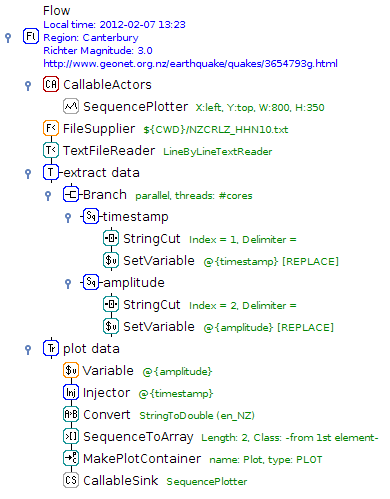About
The core of ADAMS is the workflow engine, which follows the philosophy of less is more. Instead of letting the user place operators (or actors in ADAMS terms) on a canvas and then manually connect inputs and outputs, ADAMS uses a tree-like structure. This structure and the control actors define how the data is flowing in the workflow, no explicit connections necessary. The tree-like structure stems from the internal object representation and the nesting of sub-actors within actor-handlers.
Features
Feature |
Available |
|---|---|
Machine learning/data mining |
WEKA, MOA, MEKA, parameter optimization, experiment generation on-the-fly, setup generators, time series |
Data processing |
|
Streaming |
|
Spreadsheets |
MS Excel (r/w), ODF (r/w), CSV (r/w), Gnumeric (r/w), fixed column (r/w), Matlab (r/w) |
Databases |
MySQL, SQLite, PostgreSQL, HSQL, MSSQL, Sybase, JDBC, MS Access, Redis |
Imaging |
JAI, BoofCV, OpenCV, Gnuplot, LIRE, OCR (tesseract), Barcodes (Zxing) |
Graphics support |
BMP, JPG, PNG, TIF, PDF |
Audio |
WAV, record, playback, spectrograms |
Spectral data |
AniML, CAL, CML, DPT, EEM, JCampDX, MPS, NIR, Opus, Relab, SPA, SPC, SpecLib, spreadsheet-based |
Visualization |
Scatter and line plots, Control charts, Images, video, webcams, GIS (OpenStreetMap) |
Scripting |
|
Documentation |
HTML |
Web |
HTTP, FTP, SFTP, SSH, Email, Webservices, rsync |
Other |
de/-compression (tar, zip, bzip2, gzip, lzma, xz, zstd), Java code generation |
Example flow

Horizontal and vertical indicators show how the data flows
Each actor has its own icon, since the name can be changed arbitrarily
Four types of actors: standalone (red; no input, no output), source (orange; only output), transformer (green; input and output) and sink (greyl; only input)
Control actors, i.e., actors that determine the flow of data or flow execution are blue
Actors with parameters usually show a so-called quick info on the right-hand side of the name, to give the user an idea how the actor is parametrized without having to open up the dialog with the options.